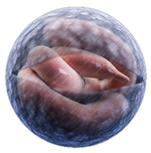|
Quick Facts
|
About Cryptosporidium
Cryptosporidium is a parasite that causes cryptosporidiosis (often called "crypto") with stomach illness symptoms such as diarrhea, vomiting, and cramps. Several species can cause infection, though C. parvum is one of the most common and well known. The parasite can be found in either the natural environment or from shedding in human and animal waste. Humans and cattle are common reservoirs for infection and fecal shedding contributes to high concentrations in surface waters.
Cryptosporidium was first diagnosed in humans in 1976 and the first documented US outbreak was in 1985. The associated illness became a nationally notifiable disease in 1994 after an outbreak in Milwaukee, WI caused over 403,000 infections, 69 attributed deaths, and an estimated economic burden of $96 million dollars due to healthcare costs and productivity losses.
Cryptosporidium is a parasite that causes cryptosporidiosis (often called "crypto") with stomach illness symptoms such as diarrhea, vomiting, and cramps. Several species can cause infection, though C. parvum is one of the most common and well known. The parasite can be found in either the natural environment or from shedding in human and animal waste. Humans and cattle are common reservoirs for infection and fecal shedding contributes to high concentrations in surface waters.
Cryptosporidium was first diagnosed in humans in 1976 and the first documented US outbreak was in 1985. The associated illness became a nationally notifiable disease in 1994 after an outbreak in Milwaukee, WI caused over 403,000 infections, 69 attributed deaths, and an estimated economic burden of $96 million dollars due to healthcare costs and productivity losses.
|
Did you know?
|
Treatment Conventional methods of water treatment frequently fail to remove or inactivate Cryptosporidium oocysts (the "egg" life stage of the parasite) from source waters. During the oocyst stage, the parasites are environmentally resistant and highly robust. Their small size and low infectious dose have added to the challenge that these organisms pose to water utilities and home owners. Although resistant to chlorine, the parasite can be removed via proper filtration - look for filters that have a pore size of 1 micron or less, Ultraviolet (UV) light, and ozone treatment. |
Related Articles




